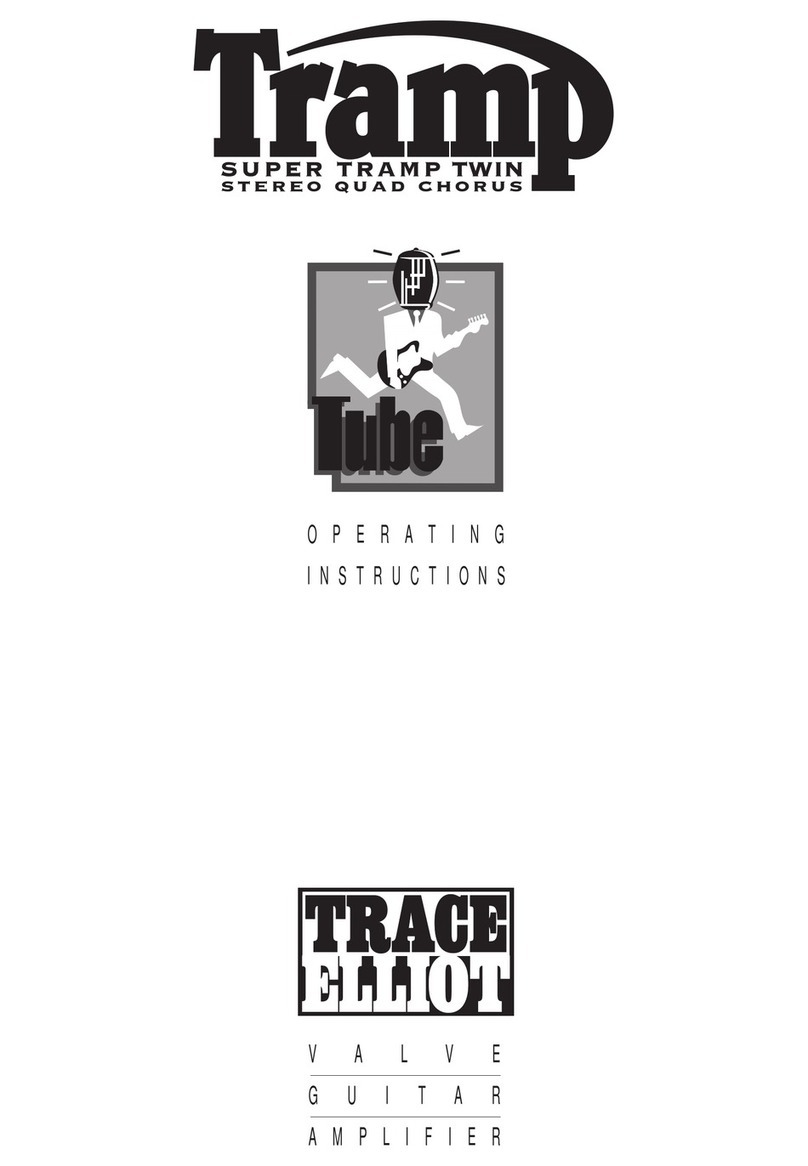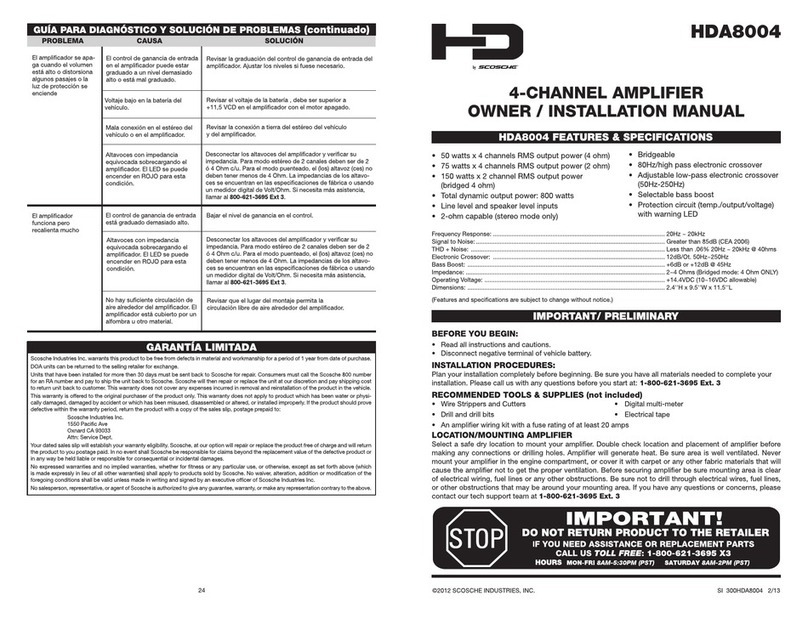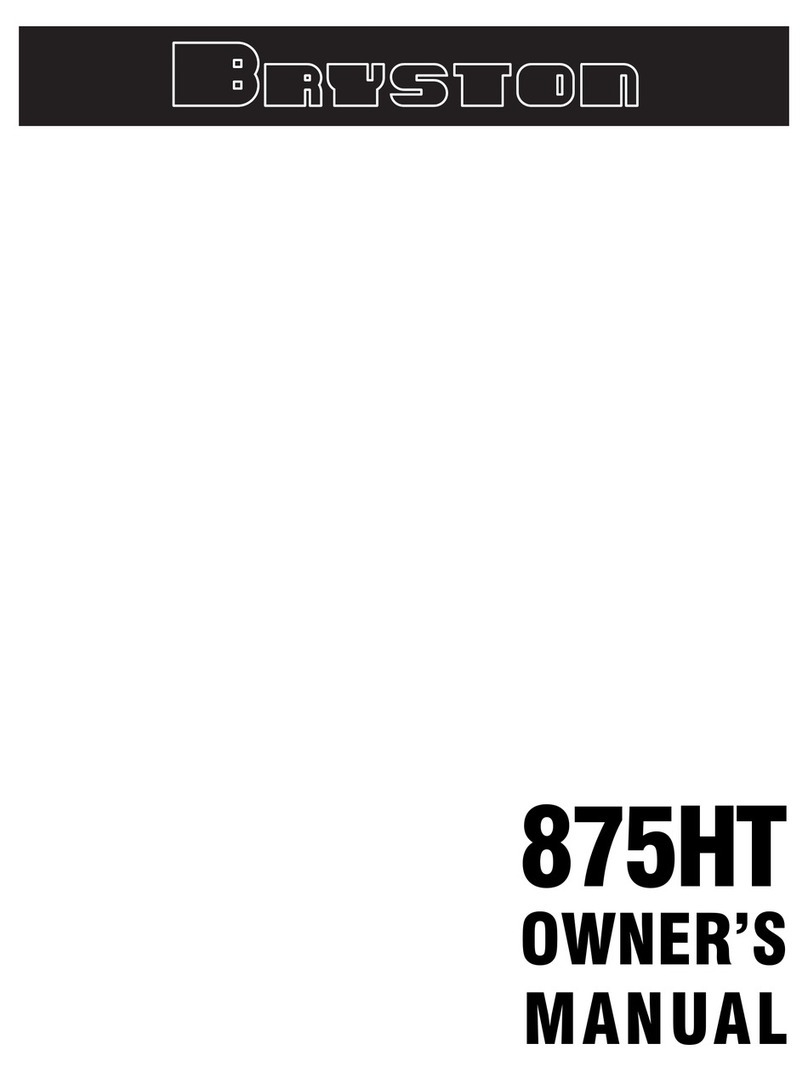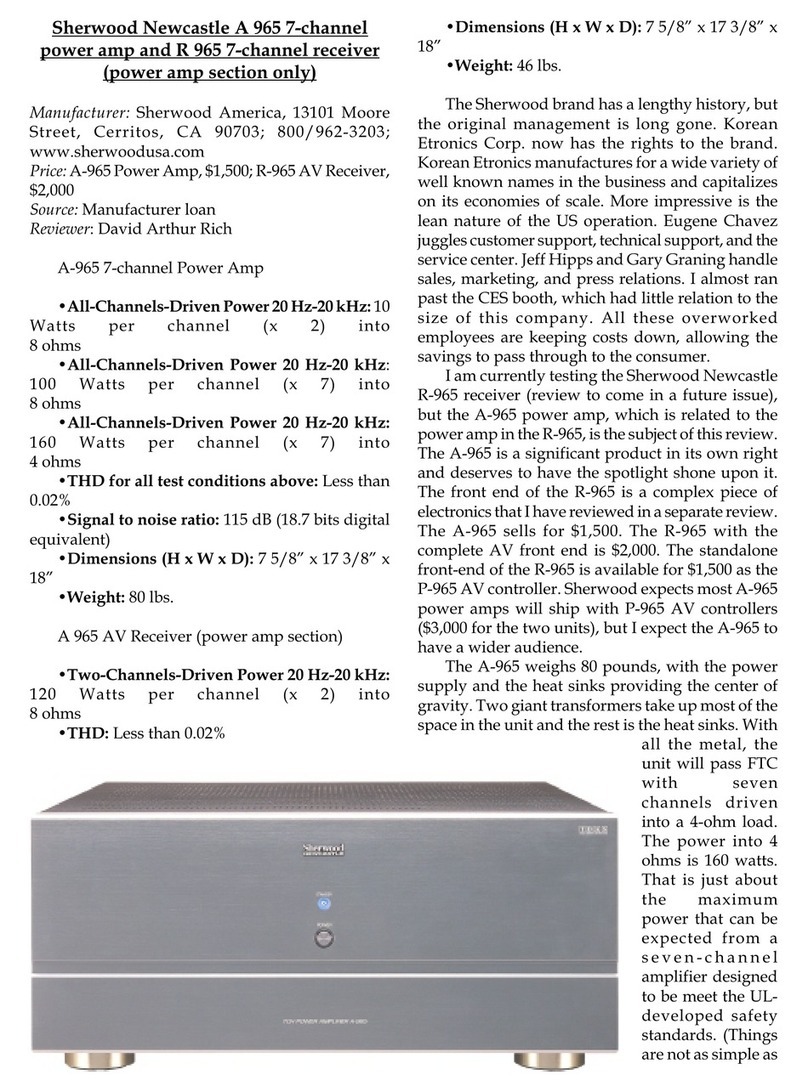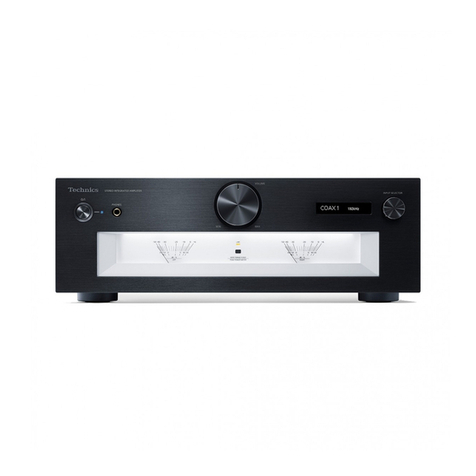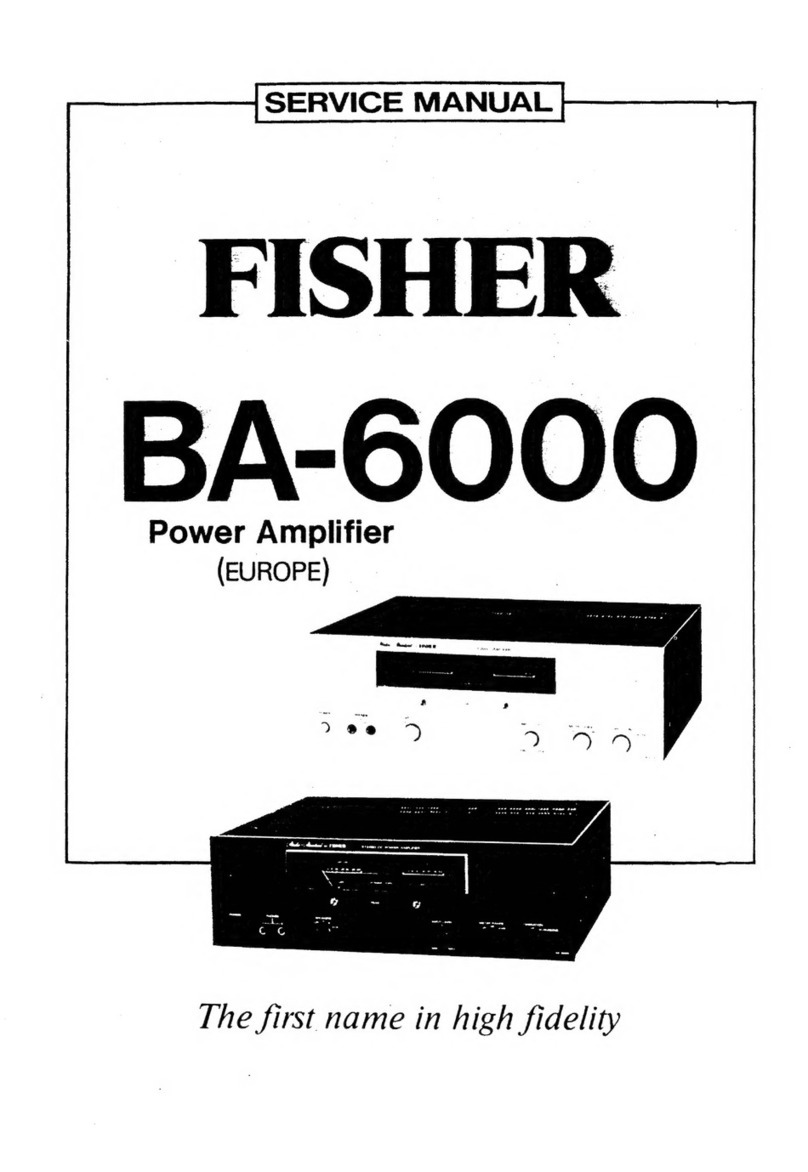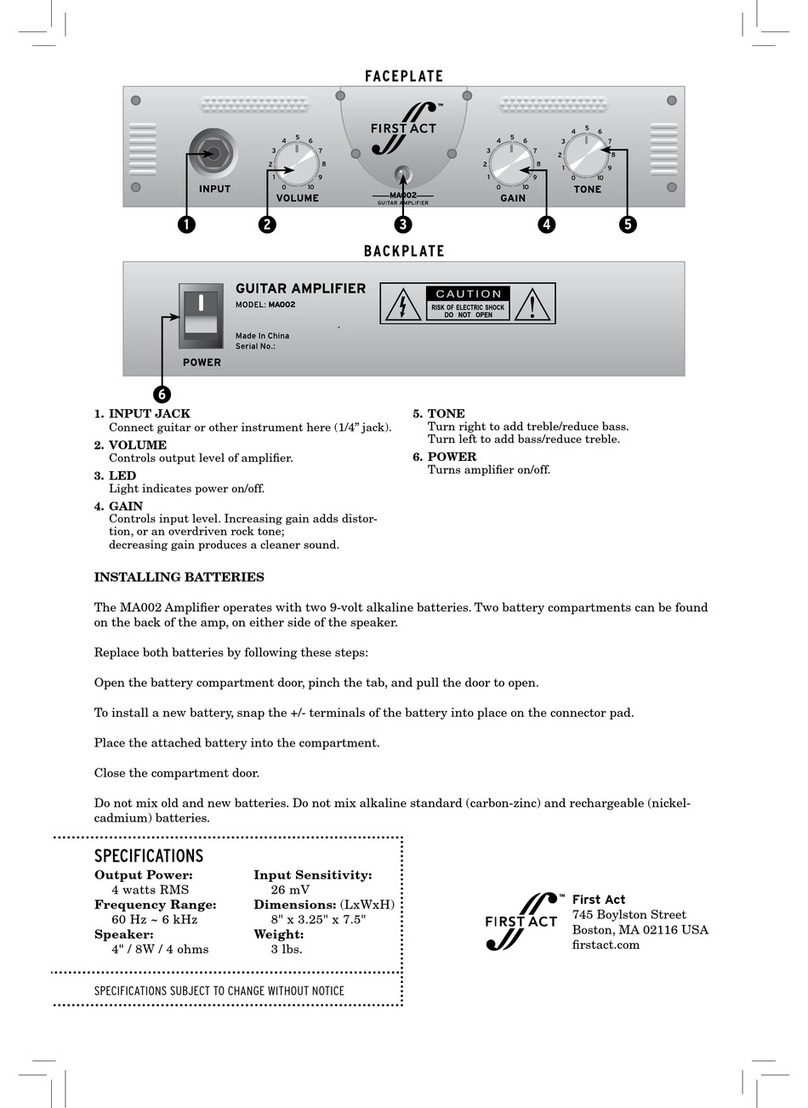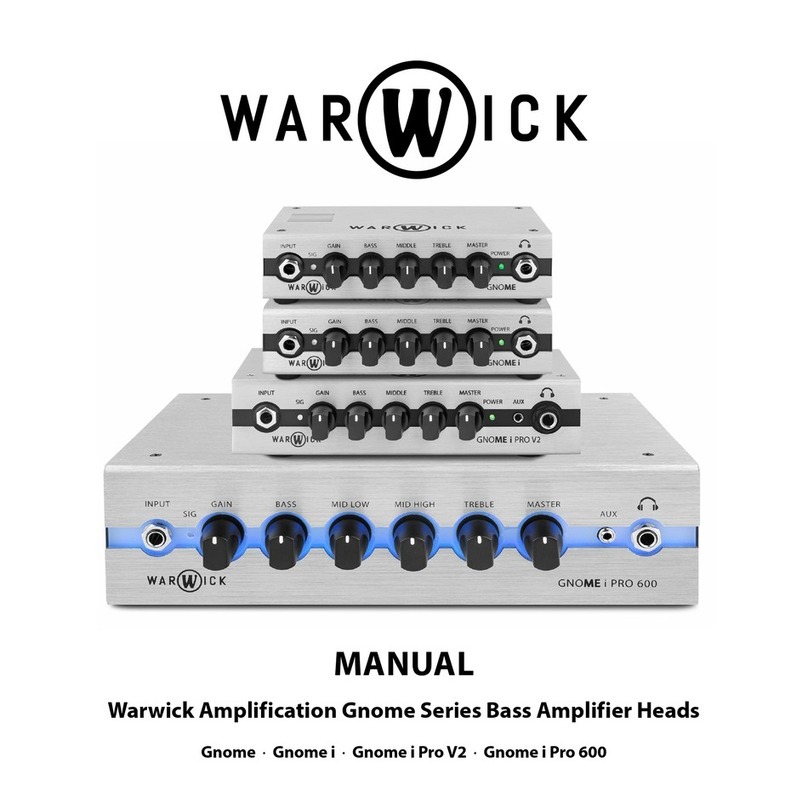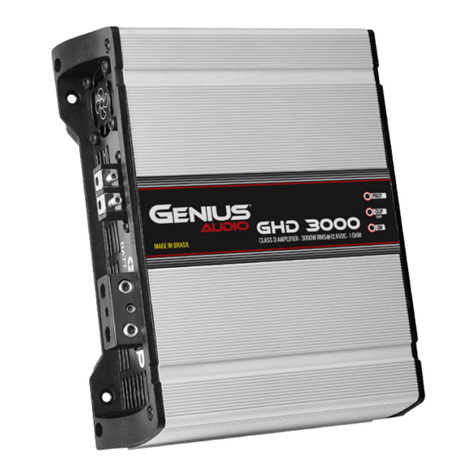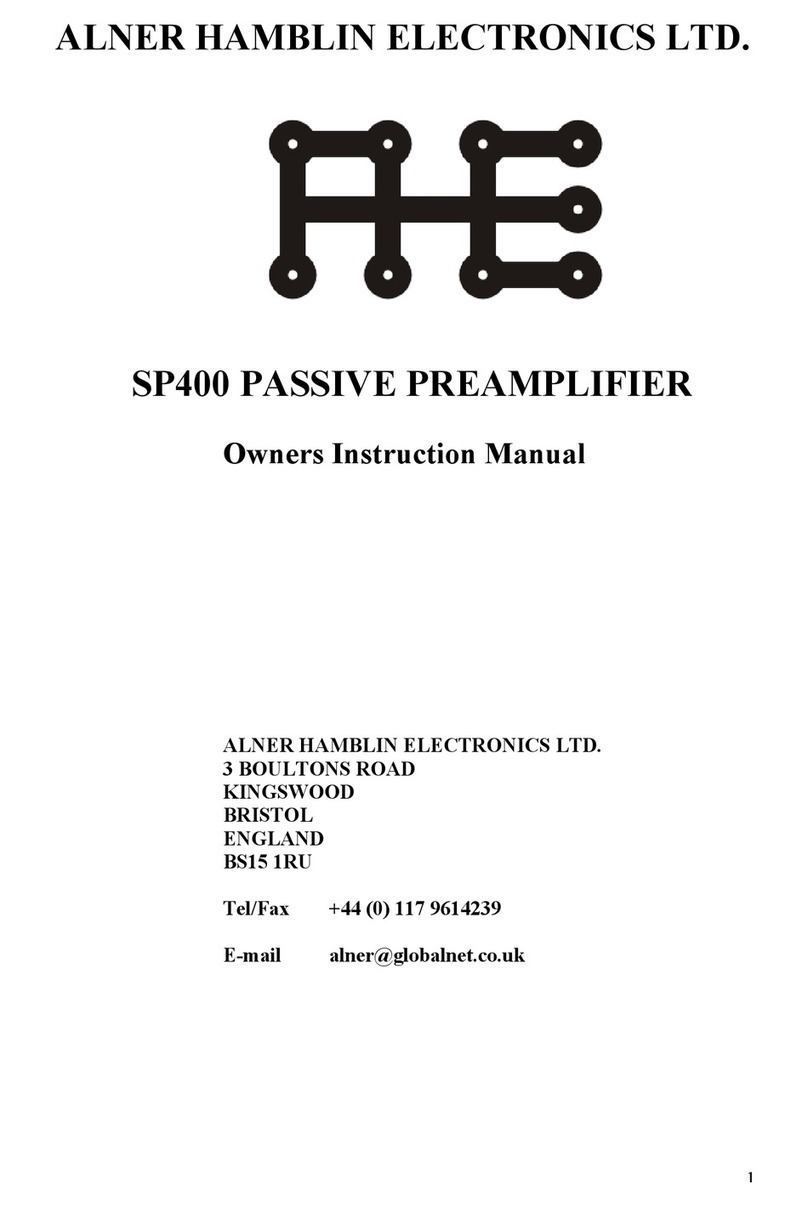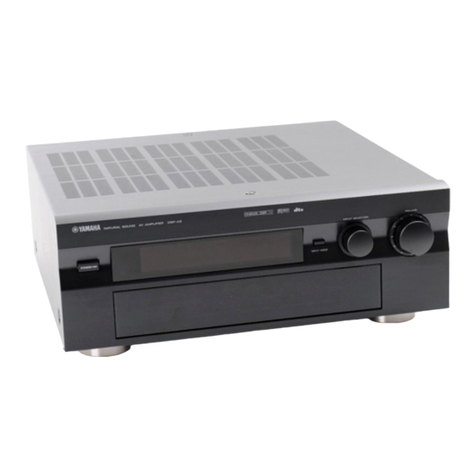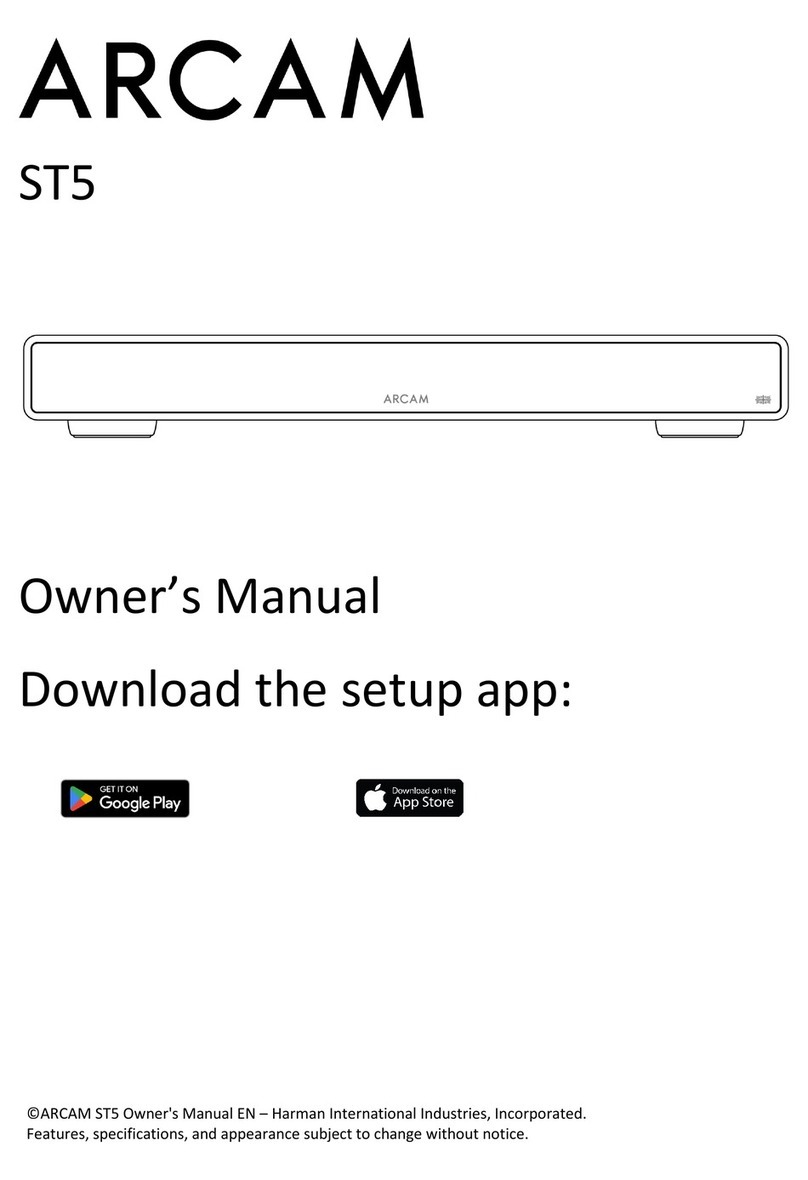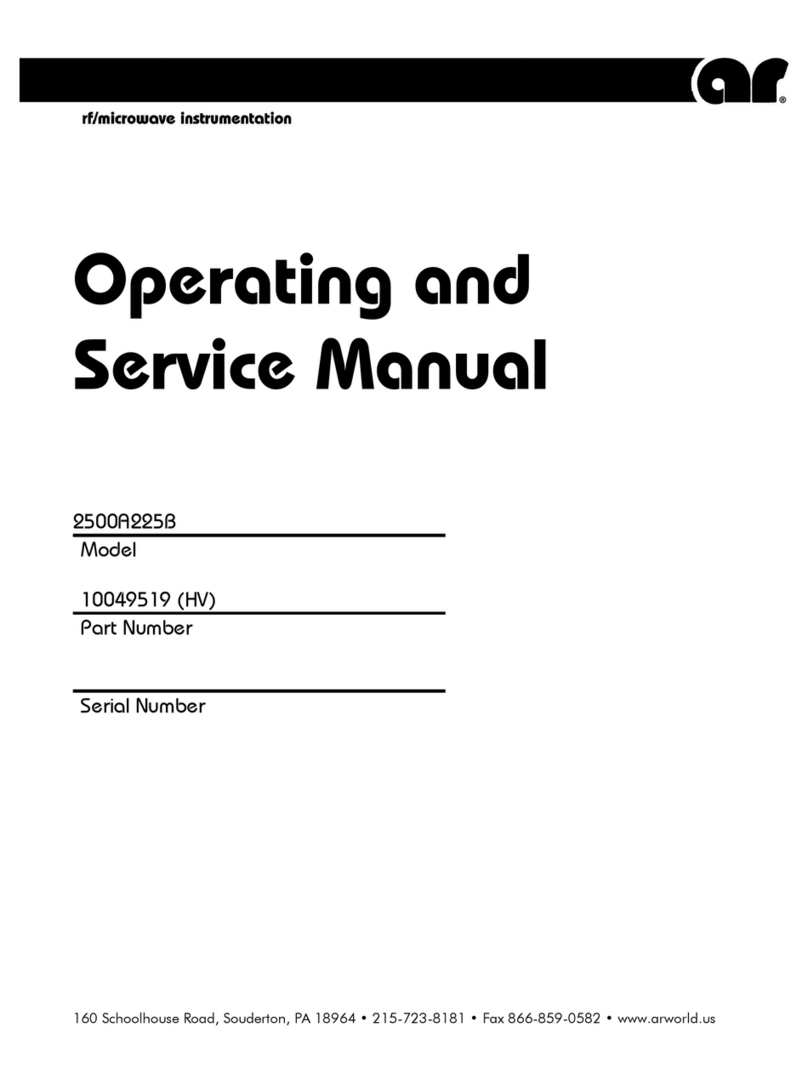TRACE ELLIOT Elf User manual

Trace Elliot® Elf
Bass Instrument Amplier
Owner’s Manual

FCC Compliancy Statement
This device complies with Part 15 of the FCC rules. Operation is subject to the following
two conditions: (1) this device may not cause harmful interference, and (2) this device
must accept any interference received, that may cause undesired operation.
Warning: Changes or modications to the equipment not approved by Peavey Electronics
Corp. can void the user’s authority to use the equipment.
Note - This equipment has been tested and found to comply with the limits for a Class
B digital device, pursuant to Part 15 of the FCC Rules. These limits are designed to
provide reasonable protection against harmful interference in a residential installation.
This equipment generates, uses and can radiate radio frequency energy and, if not
installed and used in accordance with the instructions, may cause harmful interference
to radio communications. However, there is no guarantee that interference will not occur
in a particular installation. If this equipment does cause harmful interference to radio or
television reception, which can be determined by turning the equipment off and on, the
user is encouraged to try and correct the interference by one or more of the following
measures.
• Reorient or relocate the receiving antenna.
• Increase the separation between the equipment and receiver.
• Connect the equipment into an outlet on a circuit different from that to which the
receiver is connected.
• Consult the dealer or an experienced radio/TV technician for help.
CAN ICES-3(B)/NMB/3(B)
Trace Elliot • Hwy. 5022 Hwy. 493 North • Meridian, MS 39305
Tel: (601) 486-2255 • Fax: (601) 486-1156 • www.traceelliot.us

3
Congratulations on your purchase of a Trace Elliot product. Our experience in design and quality of
manufacturing will ensure that you will be able to rely on this product to deliver the solid professional sound
you deserve, whether in the studio or on stage.
e Trace Elliot Elf packs all of the 200W of crystal-clear bass tone you would expect from our ampliers in a
miniscule package, that can easily t into a pocket! is amp sounds clean and rened, but if you push it, it will
overdrive naturally, for a smooth and musical sound. Trace Elliot is known for designing amps that sound loud
for their power ratings, and the ELF is certainly no exception!
FEATURES:
•Extremely portable 1.60 lb (0.73Kg)
•Dimensions: W = 6.75” (17.1 cm) D = 4.10” (10.4 cm) H= 1.35” (3.4cm)
•200W continuous into 4 ohms / 130W continuous into 8 ohms
•Wide range input gain control with signal level indicator
•3-band rotary equalizer that emulates the response of classic Trace Elliot multi-band graphic EQ filters
•Ultra-high preamp input impedance ( >10meg ohms) for maximum sensitivity when using passive pickups
•Post EQ balanced XLR DI output with ground lift for sending classic Trace Elliot tone to a mixing console or recording device
•1/4” (6.35mm) headphone output for quiet practice
Caution: Please look over this guide and read any caution or warning statements found within. Following
these warnings is crucial to your personal safety and the safety of your Trace Elliot product.
TRACE ELLIOT AMPLIFICATION
ENGLISH

4
1 2 3 4 5 6 7
(1) INPUT socket
is is to connect the 1/4” jack lead from your instrument. Alternatively, if any eect units are being used
before the amplier then the output from the last unit is connected here.
Experience has shown us that not all 1/4” jack plugs are made equal, therefore, we recommend the use of only
high quality 1/4” jack leads for best sonic performance and reliable connection.
(2) GAIN rotary control
is is to set the gain of the input stage of the amplier. e setting of this control is the single most important
on the whole unit. ere are three regions of operation of the control, which can be visually conrmed by the
activity of the signal LED.
(3) SIGNAL LED
When the LED is green, the instrument signal is passing through the preamp without any compression. When
the LED begins to ash red, more and more compression is occuring in the preamp as the GAIN control is
advanced. e compressor also tracks changes made to the EQ; therefore, an increase in an EQ setting will
require a decrease in the GAIN setting to maintain the same amount of compression.
When the GAIN control is at maximum clockwise rotation, a musically useful overdrive distortion
circuit is engaged. Reduce the VOLUME accordingly when using this setting.
(4) BASS, MID, and TREBLE EQ
is section is an active tone control. Adjusting these knobs clockwise from the center (0) position will amplify
the low, mid, or high frequency content. Adjusting counterclockwise from the center (0) position will attenuate
the low, mid, or high frequency content.
(5) Power Indicator
Green LED that indicates the amp is powered on.
(6) VOLUME rotary control
This sets the signal level sent to the power output stage and the Speaker Output. It should be set at “0” when
switching on the amplier and turned up to the desired playing volume slowly to avoid any sudden level
changes that could damage your hearing. When maximum power is detected, a limiter circuit is engaged,
preventing excessive power amplier clipping.
(7) Headphone Jack
This 1/4” stereo jack is for player monitoring. For silent practice, simply disconnect the speaker output and
listen through the headphones.

5
Rear Panel
98 10 11 12
(8) AC POWER INLET
is is the receptacle for an IEC line cord, which provides AC power to the unit. Connect the line cord to
this connector to provide power to the unit. Damage to the equipment may result if improper line voltage
is used. (See line voltage marking on unit).
Never break o the ground pin on any equipment. It is provided for your safety. If the outlet used does not
have a ground pin, a suitable grounding adapter should be used and the third wire should be grounded
properly. To prevent risk of shock or re hazard, always make sure that the amplier and all associated
equipment is properly grounded.
(9) ON-OFF SWITCH
is rocker switch supplies AC power to the amplier when switched to the ON position. e ON position is
with the right side of the switch pushed “in” or nearly ush with the rear panel.
(10) SPEAKER OUTPUT
is ¼” mono jack is provided for connection of an external speaker cabinet. Minimum load impedance is 4
Ohms.
Please note that this a BRIDGED amplier output, meaning the sleeve of the 1/4” jack is driven by an
amplier. Neither the tip nor sleeve of the speaker plug should ever contact ground, or damage could occur!
Also, please use only cabinets built with professional-quality bass guitar musical instrument loudspeakers.
Be aware that the protection circuitry within the ELF will detect overexcursion events caused by inferior
speakers and guitar speakers, which are not meant for bass. e protection circuits will react to these events
by momentarily interrupting the sound. If you experience interruptions, it means the speaker is exceeding
maximum excursion. As an option, reduce the volume. If this happens repeatedly, ultimately you must change
to a professional bass cabinet with adequate suspension and excursion for bass.
(11) DI GROUND LIFT switch
Pressing this switch in will disconnect the ground connection from pin 1 on the DI output XLR socket(s).
Usually this should be le in the out position however there may be certain situations when connecting from
the DI socket(s) to another device that a hum is produced due to a ground loop. If this happens then pressing
the GND LIFT switch in should eliminate the problem.
(12) DI OUT XLR
is is a low impedance balanced output for connecting direct to a stage box or mixer for live or studio use. It
gives the engineer a strong, clean signal without any overspill from other instruments. e XLR socket is wired
as normal: pin 1 = Ground, pin 2 = Signal +, pin 3 = Signal –
Note: is DI OUT XLR is congured “Post EQ”.

6
Specifications
Mains Voltage:
100-120 vac - 50/60Hz - T3.15AL/250V
230 vac - 50/60Hz - T1.6AL/250V
Power Consumption:
Typical = 30W
Maximum = 240W
SMPS:
ermal protection
Over-current protection
Power Amplier:
Protection:
Clip limiting
ermal
Over-current / Short-circuit
DC output
Minimum Load:
4 Ω
example--
1 - 4 Ω cabinet / 2 - 8 Ω cabinets
Power Output (1% THD):
130W - 8 Ω
200W - 4 Ω
Noise:
-62.5 dBu
Pre Amplier:
Nominal Input Sensitivity:
All controls @12:00 = -6.44dBu (369mV)
Input Impedance:
>10 meg Ω
EQ:
3 - band rotary type with proprietary TE lters
Low center = 80 Hz
Mid center = 400 Hz
High center = 4.2 KHz
DI XLR Balanced Output:
PIN 1 = GND, PIN 2 = sig+, PIN 3 = sig-
Post EQ
1 KΩ output impedance
w/GND li switch
noise oor = -104.3dBu
noise oor w/sig (nom.) = -88dBu
Weight:
1.6 lb (0.73 Kg)
Dimensions (H x W x D):
1.35” (3.4cm) x 6.75” (17.1cm) x 4.10” (10.4cm)

7
Warranty registration and information for U.S. customers available online at
www.traceelliot.com/warranty
or use the QR tag below

8
Features and specications are subject to change without notice.
Trace Elliot • Hwy. 5022 Hwy. 493 North • Meridian, MS 39305
Tel: (601) 486-2255 • Fax: (601) 486-1156 • www.traceelliot.us ©2010 Printed in U.S.A. 80305734
Other manuals for Elf
1
Table of contents
Other TRACE ELLIOT Amplifier manuals

TRACE ELLIOT
TRACE ELLIOT V-TYPE User manual
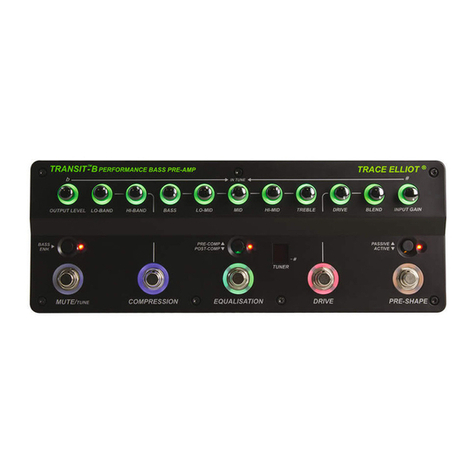
TRACE ELLIOT
TRACE ELLIOT Transit B User manual
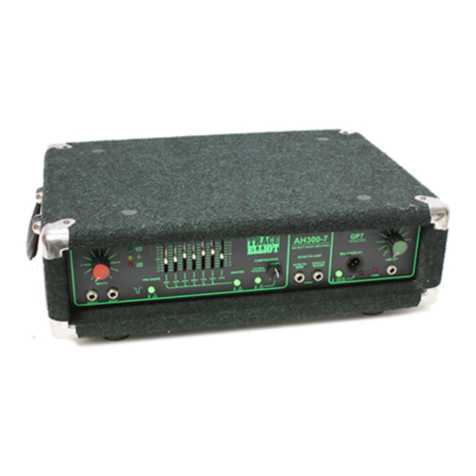
TRACE ELLIOT
TRACE ELLIOT AH300-7 User manual
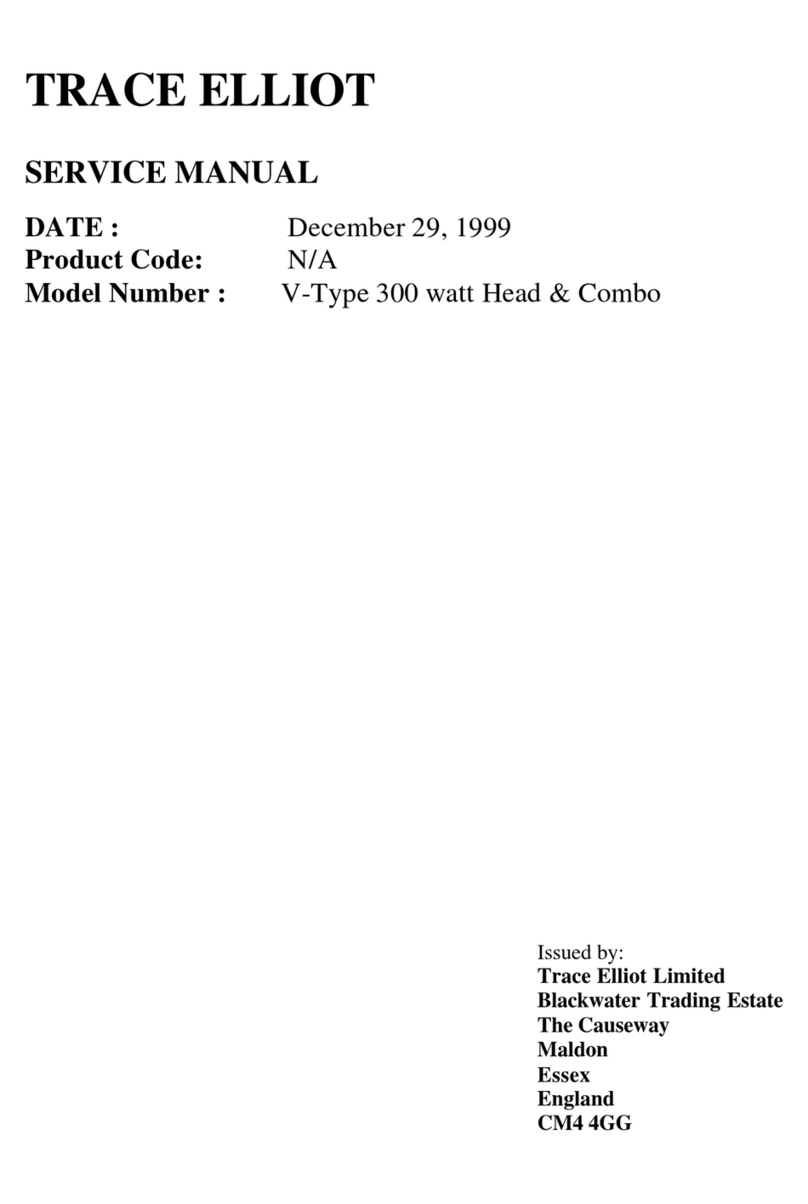
TRACE ELLIOT
TRACE ELLIOT V-TYPE User manual

TRACE ELLIOT
TRACE ELLIOT TE 1200 User manual

TRACE ELLIOT
TRACE ELLIOT TEK300 User manual
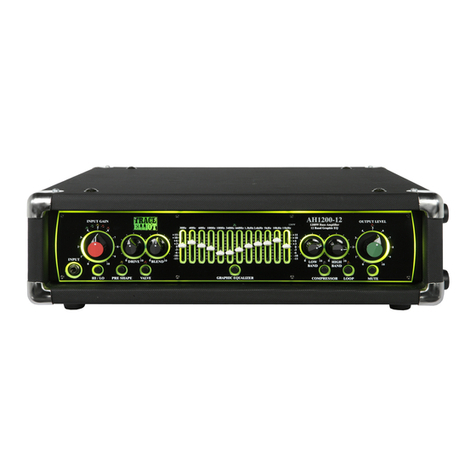
TRACE ELLIOT
TRACE ELLIOT AH1200-12 User manual
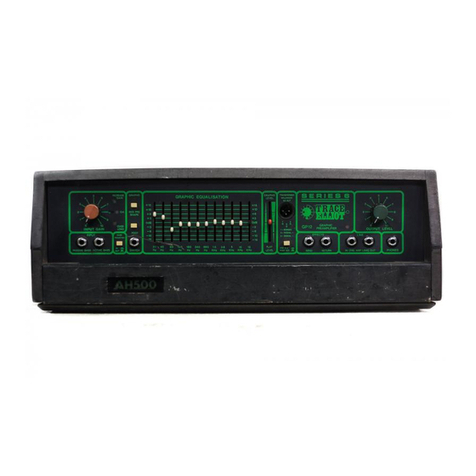
TRACE ELLIOT
TRACE ELLIOT AH500X series 6 User manual
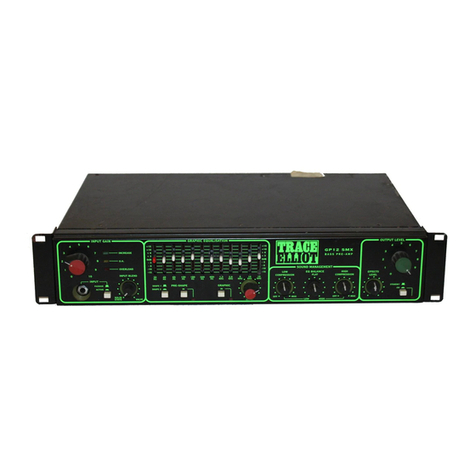
TRACE ELLIOT
TRACE ELLIOT GP12 SMX SERIES User manual
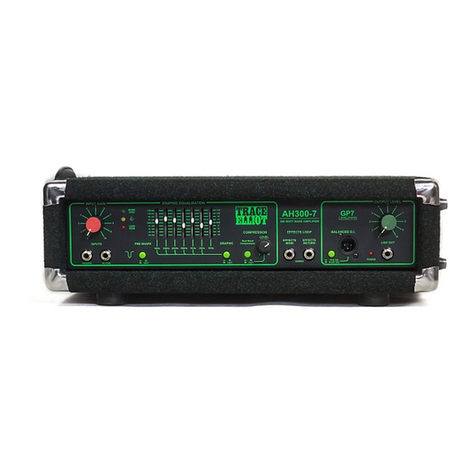
TRACE ELLIOT
TRACE ELLIOT SMC RANGE User manual
